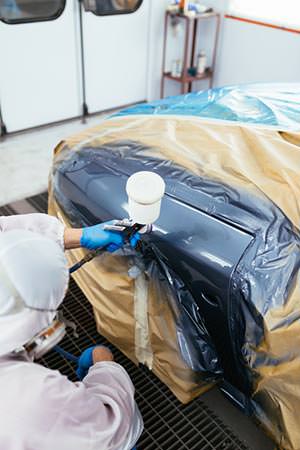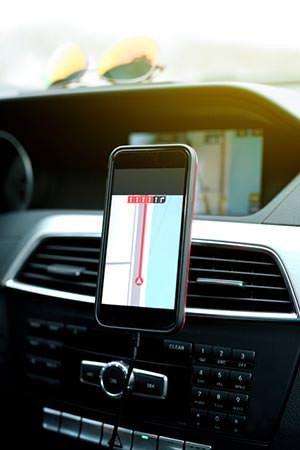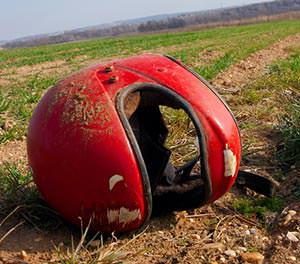victims for over 25 years.
How to Settle Your Own Property Damage Liability Claim
From time to time, we receive calls from people who were in minor accidents and they need help recouping their losses on their car or motorcycle. In these instances, I’m happy to chat with the victim on the phone and explain the process for getting compensated for their losses. However, I explain that they don’t need an attorney’s help with the process. When there are absolutely no injuries involved and the liability is clear (i.e. no one is disputing that the other guy caused the accident), you can manage the property damage claim process yourself with a little diligence and patience.
Insurance companies don’t fight too hard against pure property damage claims because cars can’t fake injuries.
Below, I’ll share the steps and also a document that can help you through the property damage claim process.
Let’s start with the basics…

If your car or motorcycle is repairable, you have two options:
-
- Get it repaired by using the other person’s insurance. The advantage to this path is that you won’t pay a deductible and, in the case of a car accident, the other driver’s insurance company must provide you with a rental car at no charge. The difficult part of choosing this path is that the other driver’s insurance company will likely make every step painful, taking their sweet time to respond to your claim. It bears noting that if you do not need a rental car, you can make a claim for “loss of use” and the carrier will pay you what it would have paid for the rental car, which typically is $20-$30 a day.
- Use your own insurance if you have it: The advantage of using your own insurance is that, because you have a contract with it, your insurance company has what’s called a “duty of good faith and fair dealing” in their relationship with you. Basically, they are supposed to be helpful. The difficulty in this path is that you will have to pay a deductible. However, your insurance company will go after the other driver’s insurance company via arbitration to be reimbursed for the full amount of your car’s repairs and they should reimburse your deductible from that settlement. Alternatively, you can send a bill directly to the at-fault driver’s insurance company demanding payment for the deductible that you had to pay. You need to send them a copy of the invoice from the mechanic or body shop, and a copy of the declarations page from your insurance showing your deductible. For the exact wording you should use, download a copy of this property damage claim letter. (Here it is as a PDF.) Finally, please note that if you do not have rental car coverage on your policy, the insurance company for the at-fault driver is still obligated to provide one for you.
(Aside: you should also pursue a loss-of-value claim.)
So, those are the over-arching steps to pursuing your own property damage claim after an accident. But there are a few additional details that you should understand.
How to Start a Property Damage Liability Claim with the Other Driver’s Insurance Company
First of all, if you were injured in a car or motorcycle accident, do not take any of the following steps on your own. Call an attorney. Why? Insurance companies don’t fight too hard against pure property damage claims because cars can’t fake injuries. They fight like crazy against people with injuries and you need legal help to take on that battle.
Now, if you weren’t injured, here’s how you start a claim:
 If you’re using your own insurance to get your car or motorcycle fixed, simply call the number on the back of your insurance card and your company will get the process rolling – you will want to have your policy number on hand before making the call. If you’re making the other driver’s insurance company pay for your damages and losses, you must call them to start a claim. I recommend the following:
If you’re using your own insurance to get your car or motorcycle fixed, simply call the number on the back of your insurance card and your company will get the process rolling – you will want to have your policy number on hand before making the call. If you’re making the other driver’s insurance company pay for your damages and losses, you must call them to start a claim. I recommend the following:
- Make sure you get a copy of the police report. (I sure hope you called the police to the accident.)
- Call the insurance company and tell them you were hit by one of their insured. They will ask you a lot of questions and you need to remember that anything you tell them might be used to limit the amount they pay you. The only information you must share is the date the accident happened, where it happened, a phone number where they can reach you, and the name and policy number for their insured, which you got at the scene of the accident.
- When the insurance company’s adjuster calls you back, you will need to provide more details about the accident. The adjuster will ask for a description of the accident – I suggest you keep this extremely simple, something along the line of “your insured ran into the back of my car” or “your insured ran a red light and hit me.” Do not go into where you were coming from or going to, or when you first saw the other car. If the other driver was cited by the police, tell the adjuster that and give him or her the case number for the report. The adjuster is the person to whom you will send that letter, so make sure you get his or her name, address, email, phone and fax information.
Often, after a body shop takes a car apart, they find more damage.
Keep Tabs on the Body Shop
Often, after a body shop takes a car apart, they find more damage. It is a good idea to follow up with your body shop and see if they have updated the estimate and submitted it to the insurance company. If the shop is waiting on parts or authorization from the insurance company, ask when the car is scheduled to be worked on again. The reason for this is that an insurance company will not pay for a rental car if your car is not being worked on in a timely fashion.
Your Duty to Mitigate Damages
After an accident, you have what’s called a “duty to mitigate your damages.” This means that you must minimize your losses and that you cannot allow bills to start piling up and expect the insurance company to cover them.
 This is particularly important when your car is towed away after an accident. You need to get it out of the tow yard as soon as possible or, alternately, tell your insurance company that they have the authority to get it out. If you don’t get it yourself or release the car to the insurance company, then you may be liable for the days that the car sits in the yard. Once you give the insurance company the authority to remove it from the yard, then they can let it sit there as long as they want because it’s their responsibility!
This is particularly important when your car is towed away after an accident. You need to get it out of the tow yard as soon as possible or, alternately, tell your insurance company that they have the authority to get it out. If you don’t get it yourself or release the car to the insurance company, then you may be liable for the days that the car sits in the yard. Once you give the insurance company the authority to remove it from the yard, then they can let it sit there as long as they want because it’s their responsibility!
Before releasing the car, however, you should go visit it and remove any valuables that remain. Also, you should take photos of the car to demonstrate the severity of the impact it sustained. Finally, I suggest you call the tow yard and ask what is required to release the car, or for you to have access to it. Some tow yards will allow you to release the car over the phone, but others require you to come in person, provide proof of ownership, and sign an authorization to release the vehicle.
Other Damages After a Car Accident
Sometimes, the damages after a car accident don’t end with your car. For example, if you have a child’s car seat, you probably know that it is not supposed to be re-used after an accident. Make sure that you take pictures of the car seat and a photo of the tag on the seat showing the brand and type. If you have a receipt for the car seat, take a picture of that, too. If you don’t have a receipt, go online and take a screenshot of the brand and type of car seat you have, showing the current price. You will need to save the seat, as the carrier may want to take it and have it destroyed. This process applies to damages done to any of your possessions in the car. Please read below for how to make a claim for other property.
Additional Thoughts for Bicycle and Motorcycle Accidents
If you’re involved in a bicycle or motorcycle accident, you will likely have damage to your possessions, such as a cracked helmet, scuffed jacket, broken cell phone, and more. You are entitled to be reimbursed for those damages, as well. Here are some tips for recovering your losses.
 Let’s say that your helmet ended up with a big scrape and a giant chip of paint. (Thank that helmet for saving your brain!) As you probably know, after a helmet has been in an accident, you’re no longer supposed to use it. Take a photo of the helmet showing the damage, and a photo of the helmet’s tag showing the brand and type. If you still have a receipt, take pictures of that, too. If you don’t have a receipt, go online and grab a screenshot of the helmet with the current price. Send that with your claim to the insurance company.
Let’s say that your helmet ended up with a big scrape and a giant chip of paint. (Thank that helmet for saving your brain!) As you probably know, after a helmet has been in an accident, you’re no longer supposed to use it. Take a photo of the helmet showing the damage, and a photo of the helmet’s tag showing the brand and type. If you still have a receipt, take pictures of that, too. If you don’t have a receipt, go online and grab a screenshot of the helmet with the current price. Send that with your claim to the insurance company.
As with the car seat example above, when the insurance company pays you for losses on your helmet, jacket, phone or other items, they typically take possession of those items. Once they pay you for them, they own them, so don’t throw them away until after you get paid.
I hope this helps you manage your own property damage claim after an accident. But I should stress again: if you (or others riding in your car or on your motorcycle) has injuries from the accident, call an attorney immediately.
Related Articles:
Worst Insurance Companies: Find out what insurance companies are rated the worst for cars and motorcycles. Also read about those our attorneys find treat their clients better.
How Social Media can Kill Your Claim: Many people have made innocent posts that have cost them thousands of dollars. Don’t make that mistake.
Free Consultation
Search For
Recent Articles
- Bicycle and Car Collision Reported on S Colorado Blvd in Denver
- Bicycle and Pickup Truck Collision Reported at S Downing St and E Louisiana Ave
- Pedestrian Injured in Traffic Incident on Bannock Street in Lincoln Park
- Traffic Incident Involving Pedestrian Reported in Central Park Neighborhood
- Possible DUI Incident Involving SUV Reported on I-70 in Sunnyside
Categories
- Arvada
- Aurora
- Auto Accident eBook
- Auto Insurance
- Bicycle
- Bicycle/Motorcycle Accidents
- Bodily injury
- Car accidents
- Centennial
- Colorado
- Colorado Legislature
- community
- Concussion
- Denver
- Denver Metro Motor Vehicle Accidents
- distracted driving
- DUI Accidents
- Englewood
- Events
- Flood Insurance
- Fort Collins
- Highlands Ranch
- Hit and Run
- In The News
- insurance companies
- Lakewood
- Littleton
- Marijuana DUI
- Motorcycle Accidents
- Motorcycle Insurance
- Motorcycle Law eBook
- Motorcycles
- Newsletter
- Pedestrian
- Personal Injury Law
- Safe Driving
- Safety
- Scooters
- technology
- Thornton
- Tips
- Uncategorized
- vibrio vulnificus bacteria
- Videos
- Westminster
- Winter Driving
Archive
- November 2024
- October 2024
- September 2024
- August 2024
- July 2024
- May 2024
- April 2024
- March 2024
- February 2024
- January 2024
- December 2023
- November 2023
- October 2023
- September 2023
- August 2023
- July 2023
- June 2023
- May 2023
- April 2023
- March 2023
- February 2023
- January 2023
- November 2022
- September 2022
- April 2022
- March 2022
- February 2022
- January 2022
- December 2021
- November 2021
- October 2021
- September 2021
- August 2021
- July 2021
- June 2021
- May 2021
- April 2021
- January 2021
- December 2020
- November 2020
- October 2020
- September 2020
- August 2020
- July 2020
- June 2020
- May 2020
- April 2020
- March 2020
- February 2020
- January 2020
- December 2019
- November 2019
- October 2019
- September 2019
- August 2019
- July 2019
- June 2019
- May 2019
- March 2019
- February 2019
- January 2019
- December 2018
- November 2018
- October 2018
- September 2018
- August 2018
- July 2018
- June 2018
- May 2018
- April 2018
- March 2018
- February 2018
- January 2018
- December 2017
- November 2017
- October 2017
- September 2017
- August 2017
- July 2017
- June 2017
- May 2017
- April 2017
- March 2017
- February 2017
- January 2017
- December 2016
- November 2016
- October 2016
- September 2016
- August 2016
- July 2016
- June 2016
- May 2016
- April 2016
- March 2016
- February 2016
- January 2016
- December 2015
- November 2015
- October 2015
- September 2015
- August 2015
- July 2015
- June 2015
- May 2015
- April 2015
- February 2015
- December 2014
- November 2014
- October 2014
- September 2014
- July 2014
- June 2014
- May 2014
- April 2014
- March 2014
- February 2014
- January 2014
- October 2012
- September 2012
- August 2012
- July 2012
- February 2012
- March 2011
- October 2010